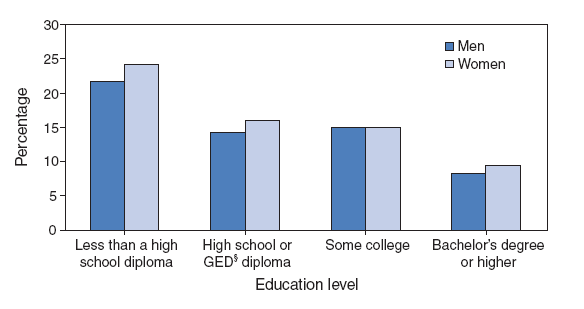
|

QuickStats: Percentage of Adults Aged >25 Years with Limitation
of Activity Caused by One or More Chronic Conditions,* by Education
Level and Sex --- National Health Interview Survey, United States,
2006†

* Limitation in usual activity is determined from responses to a series
of questions about limitations in a person's ability to engage in work,
school, play, or other activities for health reasons; the specific conditions
causing the limitations; and the duration of these conditions. Conditions lasting
>3 months are classified as chronic; selected conditions (e.g.,
arthritis, diabetes, cancer, and heart conditions) are considered chronic
regardless of duration.
† Estimates are age adjusted using the projected 2000 U.S. population as
the standard population and using four age groups: 25--44 years,
45--64 years, 65--74 years, and >75 years. Estimates are based on
household interviews of a sample of the civilian, noninstitutionalized U.S.
population. Persons who did not know whether they had a limitation and those with
a limitation who did not know whether the condition causing the limitation
was
chronic were excluded from the denominators.
§ General Educational Development.
In 2006, persons who had less than a high school diploma were more than twice as likely as persons
who had a bachelor's degree or higher to be limited in their usual activities because of one or more
chronic conditions. At lower education levels (less than a high school diploma or a high school or GED
diploma), women were more likely than men to be limited in usual activities. At higher education levels, no
significant difference in limitation was observed between men and women.
SOURCES: 2006 National Health Interview Survey. Available at
http://www.cdc.gov/nchs/nhis.htm.
Adams PF, Lucas JW, Barnes PM. Summary health statistics for the U.S. population: National
Health Interview Survey, 2006. Vital Health Stat 2008;10(236). Available at
http://www.cdc.gov/nchs/data/series/sr_10/sr10_236.pdf.
Use of trade names and commercial sources is for identification only and does not imply endorsement by the U.S. Department of
Health and Human Services.
References to non-CDC sites on the Internet are
provided as a service to MMWR readers and do not constitute or imply
endorsement of these organizations or their programs by CDC or the U.S.
Department of Health and Human Services. CDC is not responsible for the content
of pages found at these sites. URL addresses listed in MMWR were current as of
the date of publication. |
All MMWR HTML versions of articles are electronic conversions from typeset documents.
This conversion might result in character translation or format errors in the HTML version.
Users are referred to the electronic PDF version (http://www.cdc.gov/mmwr)
and/or the original MMWR paper copy for printable versions of official text, figures, and tables.
An original paper copy of this issue can be obtained from the Superintendent of Documents, U.S.
Government Printing Office (GPO), Washington, DC 20402-9371;
telephone: (202) 512-1800. Contact GPO for current prices.
**Questions or messages regarding errors in formatting should be addressed to
mmwrq@cdc.gov.
Date last reviewed: 6/4/2008
|

|
